Room Temperature Sub-ppm NO2 Gas Sensor Based on Ag/SnS2 Heterojunction Driven by Visible Light
Abstract
1. Introduction
2. Materials and Methods
2.1. Materials
2.1.1. Synthesis
2.1.2. Material Characteristics
2.2. Sensor Fabrication
2.3. Sensor Measurement and Testing Methodology
3. Results
3.1. Structural and Morphological Characterization
3.2. Gas Sensing Performances

3.3. Sensing Mechanism
4. Conclusions
Supplementary Materials
Author Contributions
Funding
Institutional Review Board Statement
Informed Consent Statement
Data Availability Statement
Conflicts of Interest
References
- Paraschiv, S.; Barbuta-Misu, N.; Paraschiv, S.L. Influence of NO2, NO and Meteorological Conditions on the Tropospheric O3 Concentration at an Industrial Station. Energy Rep. 2020, 6, 231–236. [Google Scholar] [CrossRef]
- Yuan, Z.; Zhao, Q.; Duan, Z.; Xie, C.; Duan, X.; Li, S.; Ye, Z.; Jiang, Y.; Tai, H. Ag2Te Nanowires for Humidity-Resistant Trace-Level NO2 Detection at Room Temperature. Sens. Actuators B Chem. 2022, 363, 131790. [Google Scholar] [CrossRef]
- Gamon, L.F.; Wille, U. Oxidative Damage of Biomolecules by the Environmental Pollutants NO2• and NO3•. Acc. Chem. Res. 2016, 49, 2136–2145. [Google Scholar] [CrossRef] [PubMed]
- Ambient (Outdoor) Air Pollution. Available online: https://www.who.int/news-room/fact-sheets/detail/ambient-(outdoor)-air-quality-and-health (accessed on 17 July 2025).
- Zheng, X.; Orellano, P.; Lin, H.; Jiang, M.; Guan, W. Short-Term Exposure to Ozone, Nitrogen Dioxide, and Sulphur Dioxide and Emergency Department Visits and Hospital Admissions Due to Asthma: A Systematic Review and Meta-Analysis. Environ. Int. 2021, 150, 106435. [Google Scholar] [CrossRef] [PubMed]
- Kasdagli, M.I.; Orellano, P.; Velasco, R.P.; Samoli, E. Long-term exposure to nitrogen dioxide and ozone and mortality: Update of the WHO air quality guidelines systematic review and meta-analysis. Int. J. Public Health 2024, 69, 1607676. [Google Scholar] [CrossRef]
- Rahimi, N.R.; Azhdarpoor, A.; Fouladi-Fard, R. Exposure to Tropospheric Ozone and NO2 in the Ambient Air of Tehran Metropolis: Spatiotemporal Distribution and Inhalation Health Risk Assessment. Phys. Chem. Earth Parts ABC 2024, 136, 103777. [Google Scholar] [CrossRef]
- Duan, X.; Jiang, Y.; Liu, B.; Duan, Z.; Zhang, Y.; Yuan, Z.; Tai, H. Enhancing the Carbon Dioxide Sensing Performance of LaFeO3 by Co Doping. Sens. Actuators B Chem. 2024, 402, 135136. [Google Scholar] [CrossRef]
- Tang, J.-F.; Fang, C.-C.; Hsu, C.-L. Enhanced Organic Gas Sensor Based on Cerium- and Au-Doped ZnO Nanowires via Low Temperature One-Pot Synthesis. Appl. Surf. Sci. 2023, 613, 156094. [Google Scholar] [CrossRef]
- Najafi, P.; Ghaemi, A. Chemiresistor Gas Sensors: Design, Challenges, and Strategies: A Comprehensive Review. Chem. Eng. J. 2024, 498, 154999. [Google Scholar] [CrossRef]
- Jang, Y.-W.; Jo, J.-W.; Park, S.K.; Kim, J. Room-Temperature Gas Sensors Based on Low-Dimensional Nanomaterials. J. Mater. Chem. C 2024, 12, 18609–18627. [Google Scholar] [CrossRef]
- Wu, R.; Hao, J.; Wang, Y. Recent Advances in Engineering of 2D Layered Metal Chalcogenides for Resistive-Type Gas Sensor. Small 2024, 20, 2404821. [Google Scholar] [CrossRef]
- Guo, J.; Wang, C.; Chang, X.; Zheng, W.; Zhang, J.; Liu, X. Low-Power Optoelectronic NO2 Sensors by Constructing ZnS/SnS2 Heterojunctions. ACS Appl. Electron. Mater. 2025, 7, 3552–3560. [Google Scholar] [CrossRef]
- Mishra, R.K.; Choi, H.J.; Ryu, J.W.; Choi, G.J.; Kumar, V.; Kumar, P.; Singh, J.; Kumar, S.; Gwag, J.S. Recent Progress in Gas Sensing Based on 2D SnS2 and Its Heterostructure Platforms: A Review. Sens. Actuators Phys. 2024, 365, 114860. [Google Scholar] [CrossRef]
- Zhan, S.; Zheng, L.; Xiao, Y.; Zhao, L.-D. Phonon and Carrier Transport Properties in Low-Cost and Environmentally Friendly SnS2: A Promising Thermoelectric Material. Chem. Mater. 2020, 32, 10348–10356. [Google Scholar] [CrossRef]
- Deb, S.; Mondal, A.; Ashok Kumar Reddy, Y. Review on Development of Metal-Oxide and 2-D Material Based Gas Sensors under Light-Activation. Curr. Opin. Solid State Mater. Sci. 2024, 30, 101160. [Google Scholar] [CrossRef]
- Chen, G.-X.; Xie, Z.-M.; Qu, W.-L.; Wang, D.-D.; Zhang, Q.; Zhang, J.-M. First-Principles Study of NO2 Adsorption on Noble Metals Doped SnS2/SnSe2 Heterostructure. Comput. Theor. Chem. 2025, 1245, 115099. [Google Scholar] [CrossRef]
- Lei, Z.; Lin, M.; Zhou, Y.; Huang, C.; Chen, J.; Mao, H.; Cao, J.; Ouyang, X. Glucose-modulated defect-enriched Sv-SnS2 sensor for rapid detection of NH3 at room temperature. J. Alloys Compd. 2025, 1026, 180379. [Google Scholar] [CrossRef]
- Wu, H.; Wang, X.; Chen, Y.; Wang, X. Enhanced Triethylamine-Sensing Characteristics of SnS2/LaFeO3 Composite. Chemosensors 2025, 13, 228. [Google Scholar] [CrossRef]
- Zhang, Y.; Li, Y.; Jiang, Y.; Duan, Z.; Yuan, Z.; Liu, B.; Huang, Q.; Zhao, Q.; Yang, Y.; Tai, H. Synergistic Effect of Charge Transfer and Interlayer Swelling in V2CTx/SnS2 Driving Ultrafast and Highly Sensitive NO2 Detection at Room Temperature. Sens. Actuators B Chem. 2024, 411, 135788. [Google Scholar] [CrossRef]
- Yang, H.; Li, X.; Wu, Q.; Su, H.; Ma, C.; Wang, X.; Xie, C.; Zeng, D. Synergetic Effect of Highly Active Ce Sites and Interlayer Engineering Induced by Ce Doping of SnS2 to Enhance Gas Sensing of NO2. Sens. Actuators B Chem. 2023, 376, 133033. [Google Scholar] [CrossRef]
- Zhu, L.-Y.; Ou, L.-X.; Mao, L.-W.; Wu, X.-Y.; Liu, Y.-P.; Lu, H.-L. Advances in Noble Metal-Decorated Metal Oxide Nanomaterials for Chemiresistive Gas Sensors: Overview. Nano-Micro Lett. 2023, 15, 89. [Google Scholar] [CrossRef]
- Huang, H.; Pan, Z.; Wang, J.; Wang, T.; Yang, W.; Yu, H.; Li, F.; Dong, X.; Yang, Y. Ag nanoparticles sensitized ZnO/MoS2 composites to detect ppb-level NO2 and automobile exhaust gas. Sens. Actuators B Chem. 2025, 433, 137569. [Google Scholar] [CrossRef]
- Sun, Z.; Cao, J.; Wang, S.; Zhang, Z.; Li, J.; Xu, X.; Wang, Y.; Ye, Z.; Zhang, H. LSPR Effect Enabled Ag-TiO2 Nanotube Arrays for High Sensitivity and Selectivity Detection of Acetone under Visible Light. J. Alloys Compd. 2024, 1003, 175533. [Google Scholar] [CrossRef]
- Gu, D.; Liu, W.; Wang, J.; Yu, J.; Zhang, J.; Huang, B.; Rumyantseva, M.N.; Li, X. Au Functionalized SnS2 Nanosheets Based Chemiresistive NO2 Sensors. Chemosensors 2022, 10, 165. [Google Scholar] [CrossRef]
- Wang, C.; Zhang, B.; Zhang, B.; Zhang, Z.; Chen, M.; Zhang, S.; Bala, H.; Zhang, Z. Pt-Modified Nanosheet-Assembled SnS2 Hollow Microspheres for Low Temperature NO2 Sensors. Sens. Actuators B Chem. 2024, 417, 136118. [Google Scholar] [CrossRef]
- Guo, W.; Luo, X.; Zhang, H. SnS2 Microflowers Loaded with Pt Nanoparticles with Electron Sensitization Enhanced N-Butanol Gas Sensitivity at Low Operating Temperature. Inorg. Chem. Commun. 2024, 163, 112348. [Google Scholar] [CrossRef]
- Ganesh Moorthy, S.; Bouvet, M. Effects of Visible Light on Gas Sensors: From Inorganic Resistors to Molecular Material-Based Heterojunctions. Sensors 2024, 24, 1571. [Google Scholar] [CrossRef]
- Lee, D.H.; Yoo, H. Recent Advances in Photo−Activated Chemical Sensors. Sensors 2022, 22, 9228. [Google Scholar] [CrossRef]
- Nasriddinov, A.; Zairov, R.; Rumyantseva, M. Light-Activated Semiconductor Gas Sensors: Pathways to Improve Sensitivity and Reduce Energy Consumption. Front. Chem. 2025, 13, 1538217. [Google Scholar] [CrossRef]
- Hu, J.; Zhang, J.; Liu, X.; Zhang, H.; Xue, X.-X.; Zhang, Y. Highly Selective NO2 Sensor Based on Au/SnS2 Nano-Heterostructures via Visible-Light Modulation. Appl. Surf. Sci. 2023, 623, 157093. [Google Scholar] [CrossRef]
- Qiu, P.; Qin, Y.; Wang, X. S-Vacancies and Ag Nanoparticles in SnS2 Nanoflakes for Ethanol Sensing: A Combined Experimental and Theoretical Investigation. ACS Appl. Nano Mater. 2022, 5, 10839–10847. [Google Scholar] [CrossRef]
- Yang, H.; Du, Z.; Yang, Y.; Li, X.; Wu, Q.; Tang, J.; Wang, X.; Zeng, D. Ag Intercalated SnS2 with S Vacancy and Expanded Interlayer for Enhancing NO2 Sensing. Sens. Actuators B Chem. 2023, 393, 134140. [Google Scholar] [CrossRef]
- Zhang, B.; Zhang, Z.; Wang, C.; Zhang, B.; Zhang, S.; Luo, N.; Bala, H.; Wang, Y. Ag-Modified SnS2/SnO2 Nanoheterojunctions for Low-Temperature NO2 Sensing. ACS Appl. Nano Mater. 2024, 7, 28457–28465. [Google Scholar] [CrossRef]
- Wang, S.; Shi, X.; Fang, N.; Ma, H.; Wang, J. Dual Effects of Ag Doping and S Vacancies on H2 Detection Using SnS2-Based Photo-Induced Gas Sensor at Room Temperature. Materials 2025, 18, 2687. [Google Scholar] [CrossRef]
- Gu, D.; Chen, J.; Liu, W. Visible-Light Modulated Nanostructured SnS/SnS2 Heterojunctions for Room Temperature Ppb-Level NO2 Gas Sensor. ACS Appl. Nano Mater. 2025, 8, 14342–14353. [Google Scholar] [CrossRef]
- Zhang, M.; Li, Z.; Tang, T.; Ou, R.; Zhang, B.Y.; Ma, Q.; Cheng, Y.F.; Liang, Y.; Zhuang, J.H.; Zhang, W.J.; et al. Plasmonic Au-Enabled Photo enhanced Room Temperature NO2 Sensing of 2D SnS2-Heterostructure via Single-Step Mechanochemical Synthesis. J. Alloys Compd. 2025, 1010, 177562. [Google Scholar] [CrossRef]
- Meng, L.; Wang, S.; Cao, F.; Tian, W.; Long, R.; Li, L. Doping-Induced Amorphization, Vacancy, and Gradient Energy Band in SnS2 Nanosheet Arrays for Improved Photoelectrochemical Water Splitting. Angew. Chem. Int. Ed. 2019, 58, 6761–6765. [Google Scholar] [CrossRef]
- Yang, H.; Du, Z.; Yang, Y.; Wu, Q.; Ma, C.; Su, H.; Wang, X.; Zeng, D. Ce–Ag Active Bimetallic Pairs in Two-Dimensional SnS2 for Enhancing NO2 Sensing. ACS Sens. 2024, 9, 283–291. [Google Scholar] [CrossRef]
- Cui, J.; Hu, C.; Yang, Y.; Wu, Y.; Yang, L.; Wang, Y.; Liu, Y.; Jiang, Z. Facile Fabrication of Carbonaceous Nanospheres Loaded with Silver Nanoparticles as Antibacterial Materials. J. Mater. Chem. 2012, 22, 8121–8126. [Google Scholar] [CrossRef]
- Yang, J.; Sun, L.; Hui, S.; Zhang, P.; Li, J.; Wang, D.; Wang, X.; Jiang, S. Ag Functionalized SnS2 with Enhanced Photothermal Activity for Safe and Efficient Wound Disinfection. Biomater. Sci. 2021, 9, 4728–4736. [Google Scholar] [CrossRef]
- Liu, J. Advanced Electron Microscopy of Metal–Support Interactions in Supported Metal Catalysts. ChemCatChem 2011, 3, 934–948. [Google Scholar] [CrossRef]
- Liu, D.; Tang, Z.; Zhang, Z. Visible Light Assisted Room-Temperature NO2 Gas Sensor Based on Hollow SnO2@SnS2 Nanostructures. Sens. Actuators B Chem. 2020, 324, 128754. [Google Scholar] [CrossRef]
- Liu, W.; Gu, D.; Li, X. AuPt Bimetal-Functionalized SnSe2 Microflower-Based Sensors for Detecting Sub-Ppm NO2 at Low Temperatures. ACS Appl. Mater. Interfaces 2021, 13, 20336–20348. [Google Scholar] [CrossRef] [PubMed]
- Huang, Y.; Jiao, W.; Chu, Z.; Wang, S.; Chen, L.; Nie, X.; Wang, R.; He, X. High Sensitivity, Humidity-Independent, Flexible NO2 and NH3 Gas Sensors Based on SnS2 Hybrid Functional Graphene Ink. ACS Appl. Mater. Interfaces 2020, 12, 997–1004. [Google Scholar] [CrossRef]
- Wu, R.; Yan, K.; Zhao, J.; Cai, Z.; Jian, S.; Qiu, L. 2D/2D SnS2/SnSe2 van Der Waals Heterostructure for Highly Sensitive Room-Temperature NO2 Sensor: Key Role of Interface Contact. Chem. Eng. J. 2023, 466, 143369. [Google Scholar] [CrossRef]
- Zhou, J.; Xue, K.; Liu, Y.; Liang, T.; Zhang, P.; Zhang, X.; Dai, Z. Highly Sensitive NO2 Response and Abnormal P-N Sensing Transition with Ultrathin Mo-Doped SnS2 Nanosheets. Chem. Eng. J. 2021, 420, 127572. [Google Scholar] [CrossRef]
- Yang, W.; Gan, L.; Li, H.; Zhai, T. Two-Dimensional Layered Nanomaterials for Gas-Sensing Applications. Inorg. Chem. Front. 2016, 3, 433–451. [Google Scholar] [CrossRef]
- Zhang, Q.; Ma, S.; Zhang, R.; Zhu, K.; Tie, Y.; Pei, S. Optimization NH3 Sensing Performance Manifested by Gas Sensor Based on Pr-SnS2/ZnS Hierarchical Nanoflowers. J. Alloys Compd. 2019, 807, 151650. [Google Scholar] [CrossRef]
- Sun, Q.; Li, Y.; Hao, J.; Zheng, S.; Zhang, T.; Wang, T.; Wu, R.; Fang, H.; Wang, Y. Increased Active Sites and Charge Transfer in the SnS2/TiO2 Heterostructure for Visible-Light-Assisted NO2 Sensing. ACS Appl. Mater. Interfaces 2021, 13, 54152–54161. [Google Scholar] [CrossRef]
- Kim, Y.; Park, B. Photo-Persistent Effect-Induced Energy Band Bending at the TiO2/Ag Nanoparticle Surface Plasmonic Interface. Mater. Lett. 2022, 316, 132001. [Google Scholar] [CrossRef]
- Sun, Y.; Hu, J.; Zhang, Y. Visible Light Assisted Trace Gaseous NO2 Sensor with Anti-Humidity Ability via LSPR Enhancement Effect. Sens. Actuators B Chem. 2022, 367, 132032. [Google Scholar] [CrossRef]

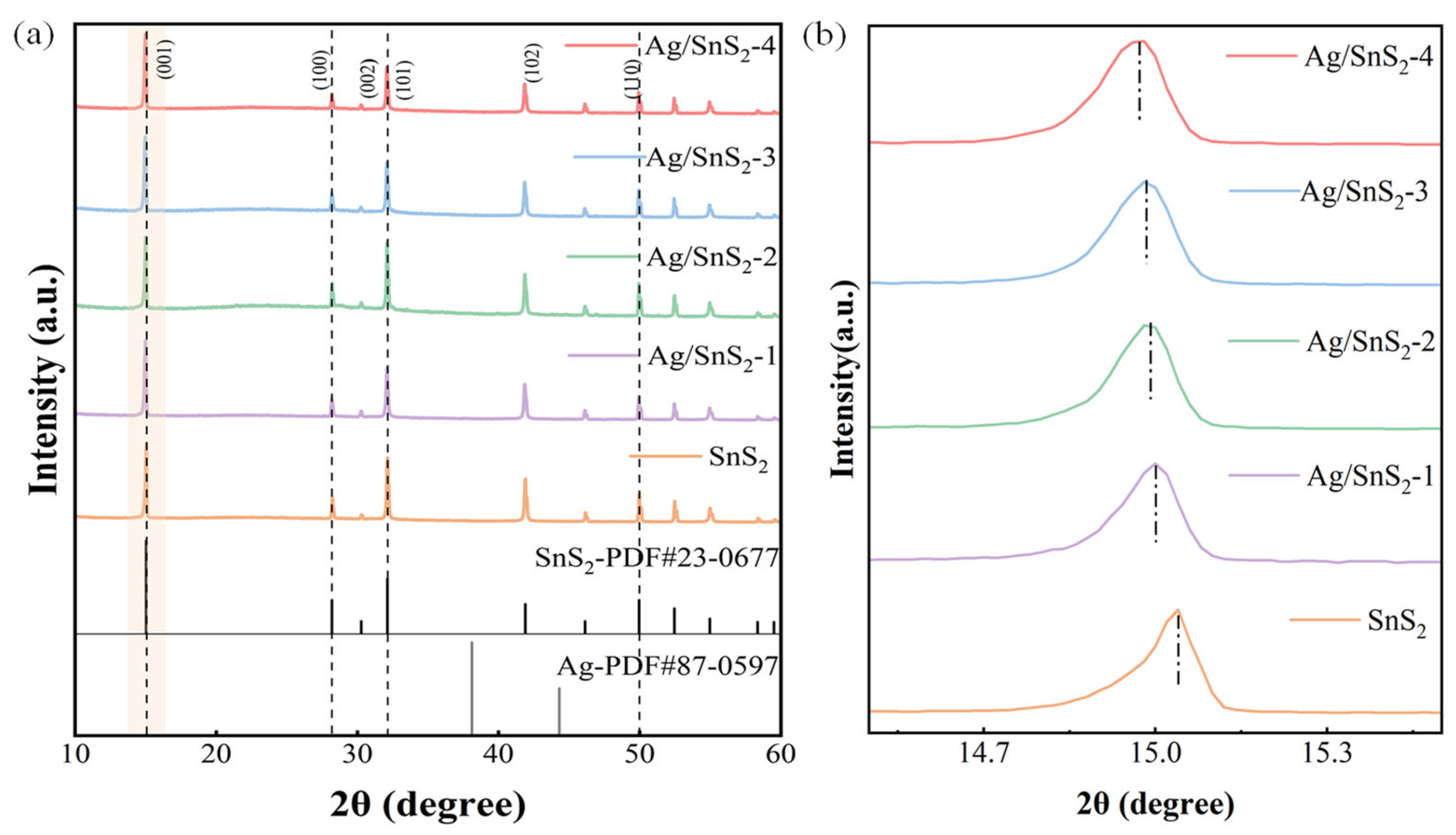

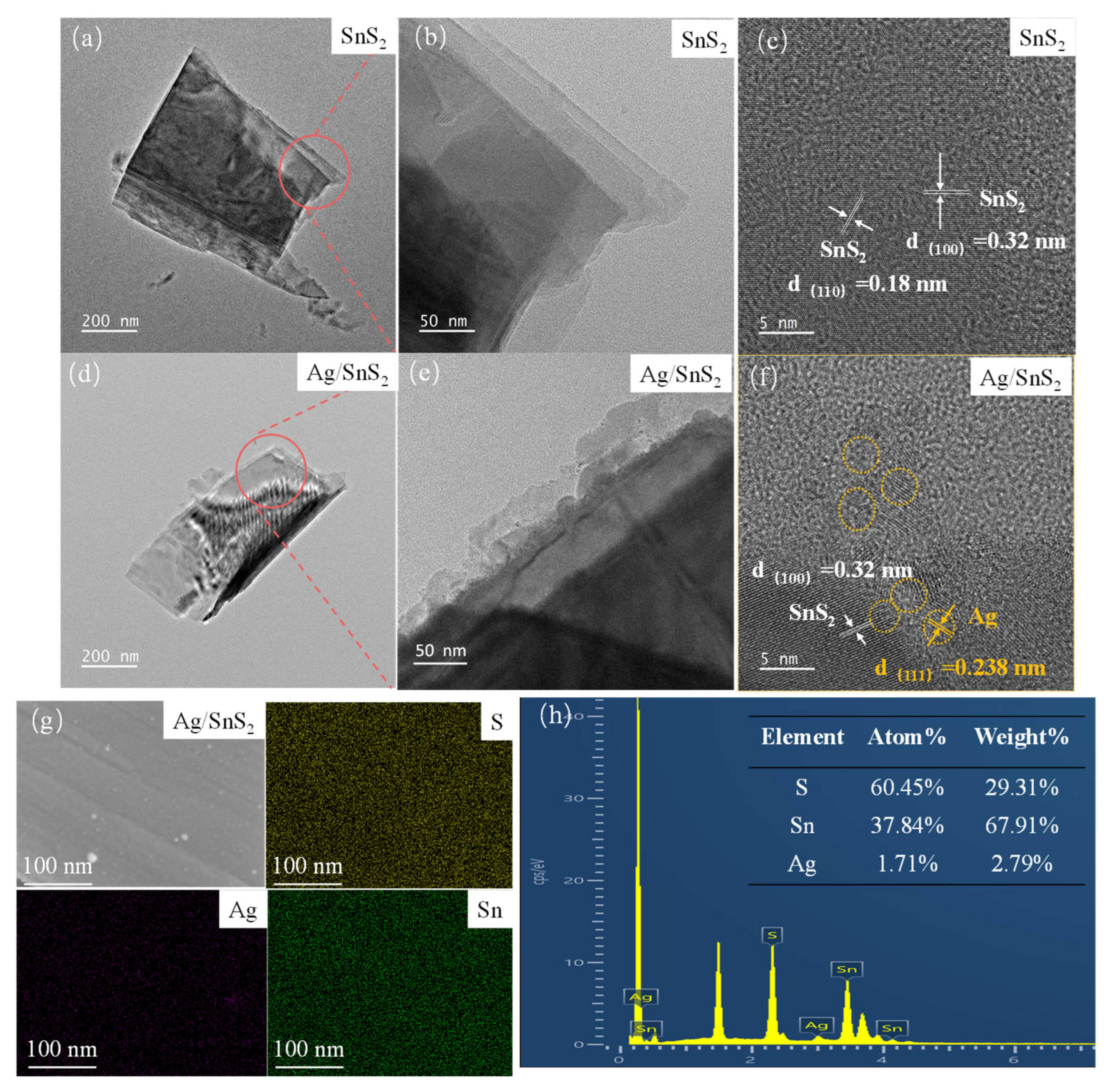
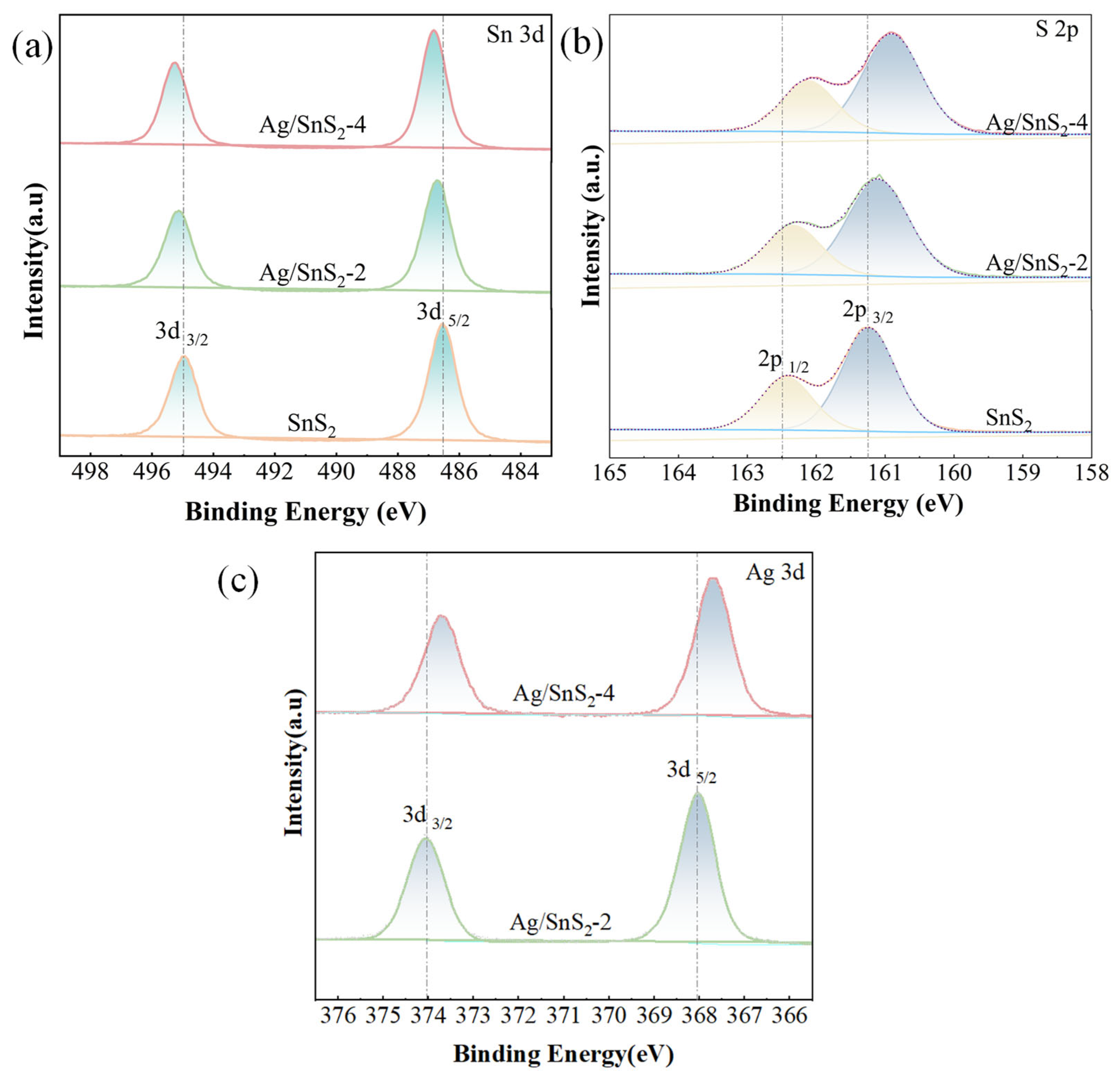
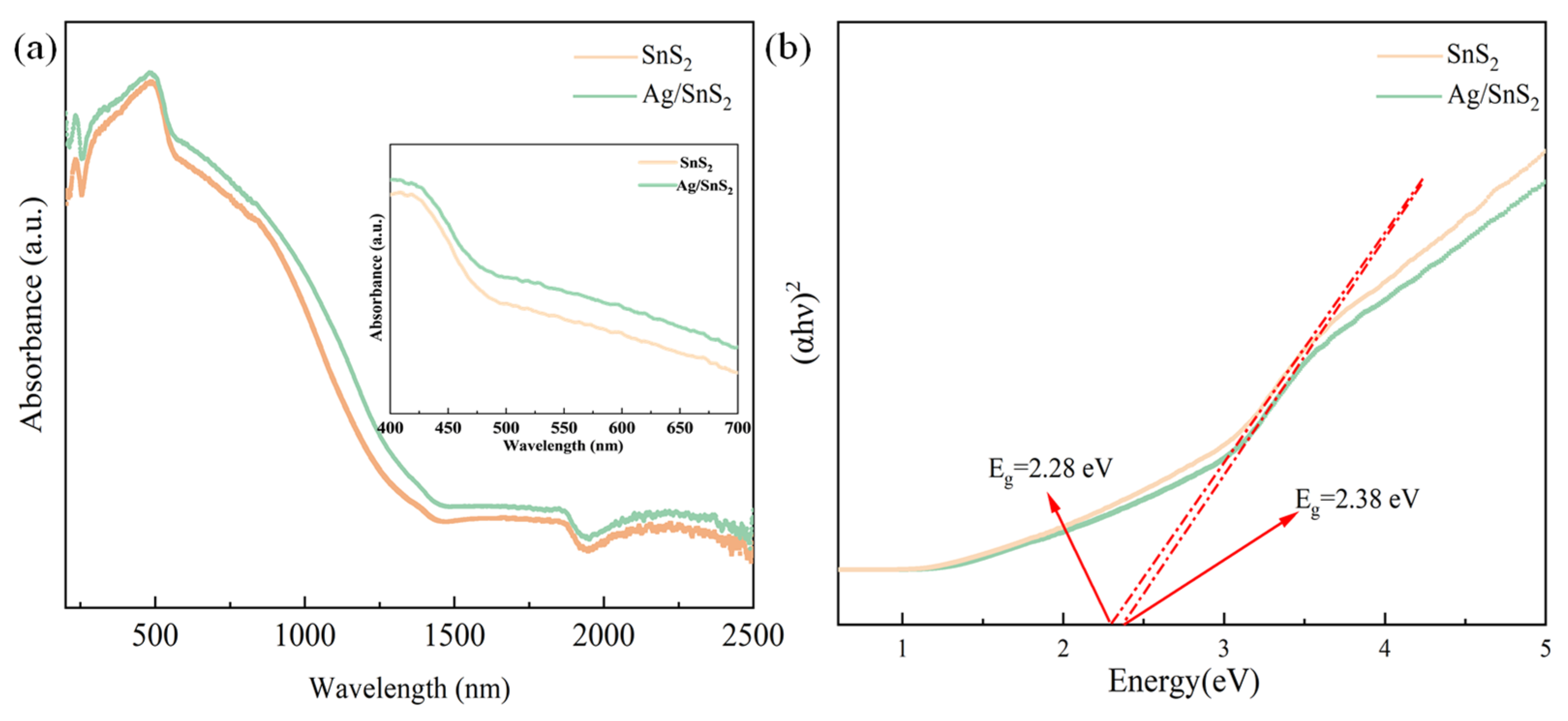
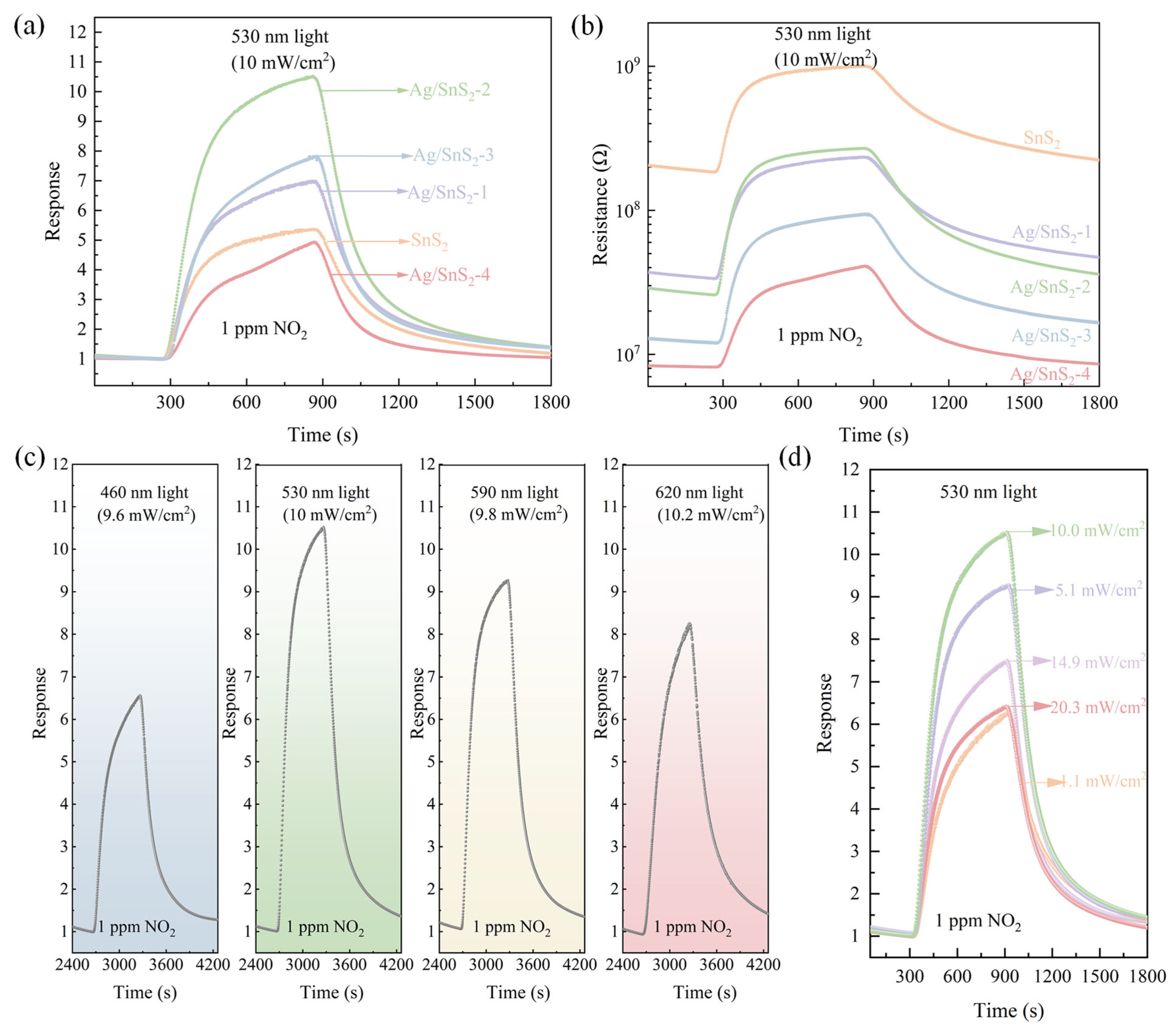


| Gas Sensing Material | Operation Condition | NO2 (ppm) | Response (Rg/Ra) | Ref. |
|---|---|---|---|---|
| SnS2/graphene | RT | 1 | 1.75 | [45] |
| SnS2/SnSe2 heterostructures | RT | 2 | 6.99 | [46] |
| Mo-SnS2 | 150 °C | 100 | 1.74 | [47] |
| Ag-SnS2 nanoflowers | 100 °C | 5 | 8.37 | [33] |
| Au/SnS2 heterostructures | RT 420 nm | 1 | 3.10 | [31] |
| Ag/SnS2 nanosheet | RT 530 nm | 1 0.2 | 10.5 1.8 | This work |
Disclaimer/Publisher’s Note: The statements, opinions and data contained in all publications are solely those of the individual author(s) and contributor(s) and not of MDPI and/or the editor(s). MDPI and/or the editor(s) disclaim responsibility for any injury to people or property resulting from any ideas, methods, instructions or products referred to in the content. |
© 2025 by the authors. Licensee MDPI, Basel, Switzerland. This article is an open access article distributed under the terms and conditions of the Creative Commons Attribution (CC BY) license (https://creativecommons.org/licenses/by/4.0/).
Share and Cite
Gu, D.; Dong, J.; Liu, W.; Li, X. Room Temperature Sub-ppm NO2 Gas Sensor Based on Ag/SnS2 Heterojunction Driven by Visible Light. Chemosensors 2025, 13, 368. https://doi.org/10.3390/chemosensors13100368
Gu D, Dong J, Liu W, Li X. Room Temperature Sub-ppm NO2 Gas Sensor Based on Ag/SnS2 Heterojunction Driven by Visible Light. Chemosensors. 2025; 13(10):368. https://doi.org/10.3390/chemosensors13100368
Chicago/Turabian StyleGu, Ding, Jun Dong, Wei Liu, and Xiaogan Li. 2025. "Room Temperature Sub-ppm NO2 Gas Sensor Based on Ag/SnS2 Heterojunction Driven by Visible Light" Chemosensors 13, no. 10: 368. https://doi.org/10.3390/chemosensors13100368
APA StyleGu, D., Dong, J., Liu, W., & Li, X. (2025). Room Temperature Sub-ppm NO2 Gas Sensor Based on Ag/SnS2 Heterojunction Driven by Visible Light. Chemosensors, 13(10), 368. https://doi.org/10.3390/chemosensors13100368





